These seven heritage animal tallow soap recipes will elevate your natural skincare routine: traditional grass-fed beef tallow basic soap, sheep tallow with lavender, mixed heritage tallow with essential oils, creamy goat tallow and milk soap, deer tallow woodsman's soap, triple-rendered bear tallow rustic bars, and homestead mixed animal fat soap. You'll discover each recipe's unique properties, from superior moisturizing to gentle cleansing, along with essential oil pairings and proper curing times. Let's explore these time-tested formulations that transform simple animal fats into luxurious, sustainable skincare.
Traditional Grass-Fed Beef Tallow Basic Soap
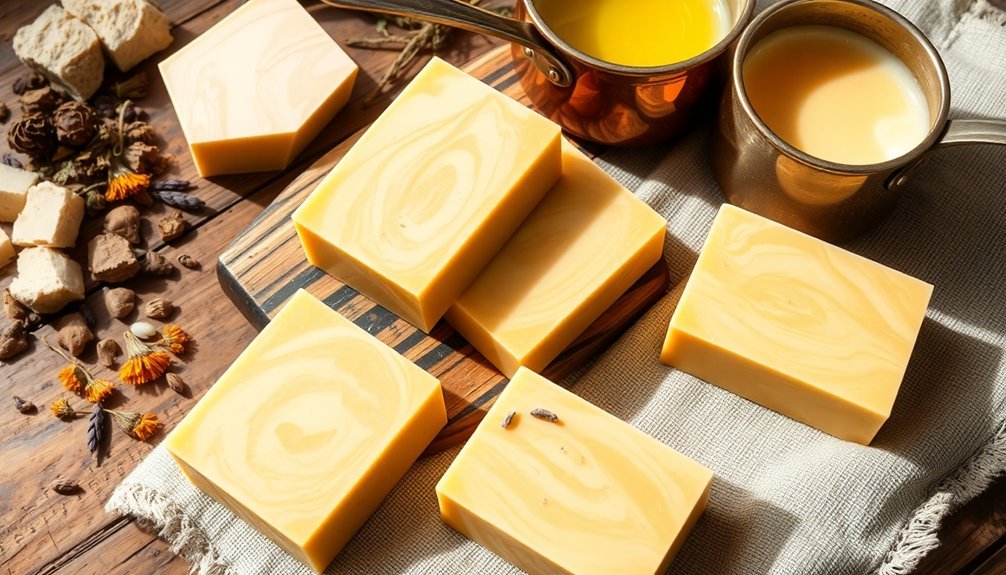
This time-honored recipe for grass-fed beef tallow soap combines the rich skincare benefits of traditional animal fats with modern soap-making techniques.
You'll need grass-fed beef tallow, coconut oil, olive oil, lye, and distilled water for this cold process soap making method.
Begin by creating your lye solution, carefully mixing lye with distilled water.
Meanwhile, melt your tallow and oils to 100-110°F.
When both mixtures reach the proper temperature, combine them and blend until you achieve trace consistency, similar to light pudding.
At this point, you can add essential oils for fragrance.
Pour your mixture into molds and let it set for 24-48 hours.
After demolding, your natural skincare bars need a proper curing time of 4-6 weeks to develop their full moisturizing properties.
The finished soap bars will contain nourishing vitamins A, D, E, and K.
Sheep Tallow and Lavender Cleansing Bars
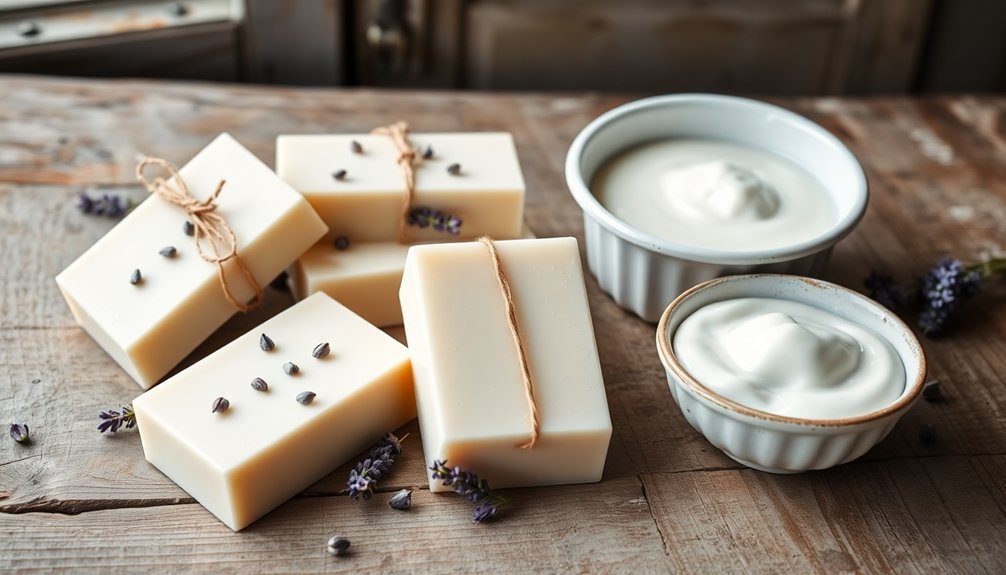
For those seeking an alternative to beef tallow, sheep tallow offers unique benefits in soap making.
You'll find that its superior cleansing properties, combined with lavender's soothing fragrance, create an exceptional hard bar soap that won't turn goopy with use.
- Creates thick, fluffy lather with small, dense bubbles
- Features a 5% superfat ratio for enhanced moisturizing qualities
- Maintains shape and consistency longer than other soaps
- Includes lavender's natural calming properties for skin benefits
- Requires precise temperature control to reach proper trace stage
When crafting these soap recipes, you'll notice how sheep tallow's distinctive characteristics blend perfectly with lavender essential oil.
The result is a luxurious cleansing bar that delivers both practical durability and aromatherapeutic benefits.
This combination produces a bar that's not only effective but also a pleasure to use in your daily skincare routine.
Mixed Heritage Tallow With Essential Oils
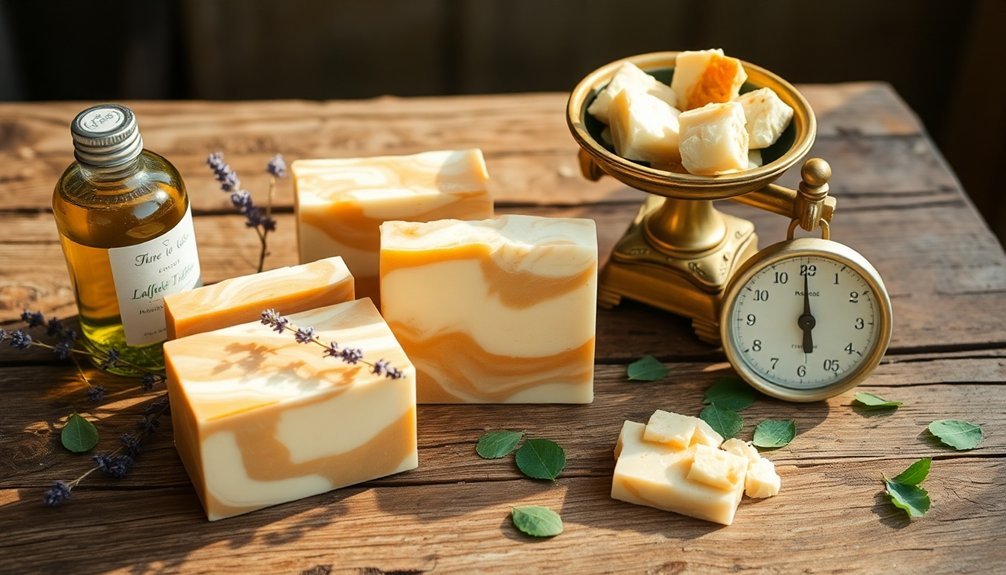
By combining different heritage animal tallows, you'll create a soap with enhanced cleansing and moisturizing properties that surpasses single-tallow varieties.
You can amplify these benefits by adding up to 4 teaspoons of essential oils like lavender, rosemary, or tea tree, which complement the tallow's natural skin-nourishing qualities.
Using traditional processing methods, you'll need to carefully calculate your lye ratios for each tallow type to guarantee proper saponification and achieve the best balance of cleansing power and skin conditioning.
Multi-Tallow Blend Benefits
While traditional single-tallow soaps offer excellent benefits, combining multiple heritage tallow types with essential oils creates a superior cleansing experience that maximizes both functionality and therapeutic value.
You'll find that multi-tallow blends from grass-fed animals deliver an ideal fatty acid profile, enhancing your skin health and moisturizing properties.
- Beef tallow provides hardness and longevity to your soap bars
- Sheep tallow increases cleansing qualities and creates luxurious lather
- Goat tallow adds extra moisturizing benefits for sensitive skin
- Combined heritage tallow sources improve overall nutrient content
- Essential oils complement the tallow blend with therapeutic properties
In soap making, these carefully crafted combinations let you customize your bars to match specific skin needs while maintaining the superior qualities that heritage tallow naturally provides.
Essential Oil Pairing Guide
Now that you understand the benefits of mixed heritage tallow soaps, selecting the right essential oil combinations can transform your soap-making experience.
You'll want to balance your essential oils carefully, using no more than 4 teaspoons per batch of tallow soap.
For an uplifting blend, try citrus oils, which offer skin-brightening properties that enhance your tallow soap's nourishing effects.
If you're seeking relaxation, lavender essential oil provides calming benefits, especially for sensitive skin.
Need an energizing start to your day? Add peppermint oil for an invigorating, cooling sensation.
Create a grounding experience by combining cedarwood and sandalwood with your tallow soap.
These earthy oils offer calming properties that complement the soap's natural richness while promoting a sense of tranquility.
Traditional Processing Methods
Three foundational steps define traditional heritage tallow processing, starting with careful fat selection and slow rendering techniques.
You'll find that combining multiple heritage animal tallow sources creates unique fatty acid profiles that enhance your soap's properties. When rendering fat, maintain low heat to preserve the natural benefits while ensuring proper purification.
- Select quality beef tallow and other heritage fats for excellent skin benefits
- Render fat slowly at low temperatures (150-170°F) for 4-6 hours
- Strain the rendered tallow through cheesecloth for clarity
- Blend complementary essential oils during the soap-making process
- Store in airtight containers to maintain freshness
This traditional processing method supports sustainability while producing superior artisanal tallow soaps.
You'll notice the calming effects of added essential oils enhance your final product, creating a perfect balance between heritage craftsmanship and modern therapeutic benefits.
Creamy Goat Tallow and Milk Soap

You'll discover remarkable skin-nourishing benefits when using creamy goat tallow and milk soap, as its natural fatty acids and vitamins work together to deeply moisturize your skin.
The combination of goat tallow's rich properties with goat milk creates a gentle cleansing experience that won't strip your skin's natural oils.
The soap's creamy texture provides mild exfoliation while the milk proteins help maintain your skin's moisture balance, making it an excellent choice for daily skincare.
Natural Moisturizing Properties
Moisture-rich goat tallow and milk soap offers exceptional benefits for those seeking natural skincare solutions.
You'll experience deep hydration thanks to the fatty acids and essential vitamins found in goat tallow, while the creamy lather works to nourish your skin without stripping away its natural oils.
- Natural fatty acids in tallow help maintain your skin's protective barrier
- Vitamins A, D, and E provide deep moisturizing properties
- Lactic acid from goat milk gently exfoliates dead skin cells
- Creamy lather cleanses while maintaining skin hydration
- Sustainable sourcing supports local farms and ethical practices
The combination of goat tallow and milk creates a luxurious soap that's particularly beneficial if you're dealing with dry or sensitive skin.
You'll notice smoother, more radiant skin as the natural moisturizing properties work to improve your skin's texture and appearance.
Gentle Exfoliating Benefits
Natural exfoliation meets gentle cleansing in creamy goat tallow and milk soap, offering a balanced approach to skin renewal.
You'll find this soap particularly gentle on the skin while delivering powerful exfoliating benefits through its alpha-hydroxy acids derived from goat milk.
The combination of creamy goat tallow and milk provides deep nourishment while maintaining a healthy skin barrier.
It's especially beneficial for sensitive skin and various skin conditions, as the tallow's fatty acids mirror your body's natural lipids.
When enhanced with natural ingredients like oatmeal or honey, you'll experience additional soothing benefits and improved texture.
The soap's moisturizing properties work in harmony with its gentle exfoliating action, revealing softer, smoother skin without the irritation commonly found in conventional soaps.
[DIRECTIONS]:
Deer Tallow Woodsman's Soap
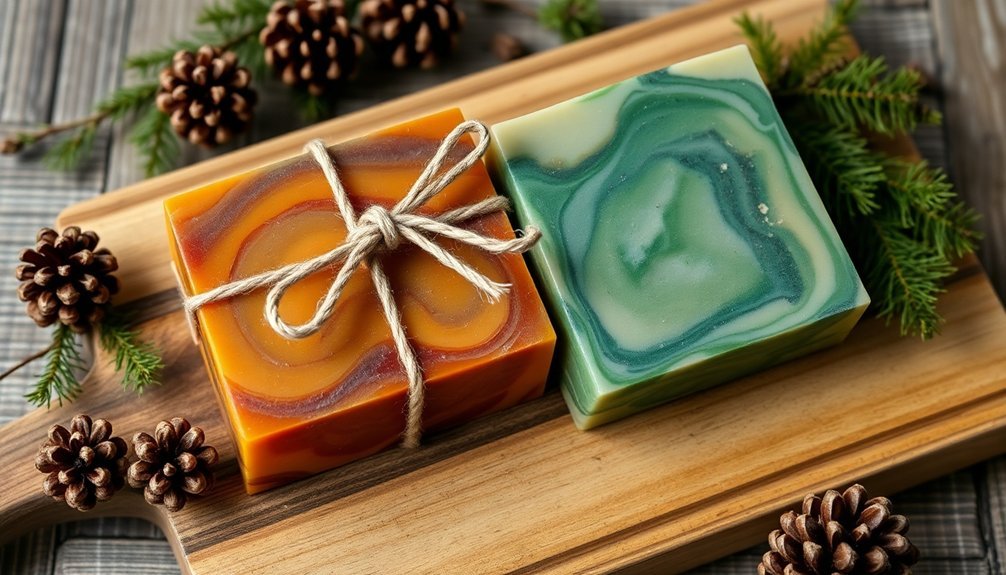
Outdoorsmen and wilderness enthusiasts have long treasured deer tallow soap for its exceptional cleansing and nourishing properties. The rendered fat creates a uniquely moisturizing bar that's perfect for those who brave the elements.
You'll find this heritage soap delivers effective cleansing while maintaining your skin's natural oils, regardless of your skin type.
- Combines deer tallow with coconut oil for an ultra-creamy lather
- Features invigorating essential oils like pine and cedarwood
- Provides superior moisturizing properties for dry, outdoor-exposed skin
- Creates a harder, longer-lasting bar that won't dissolve quickly
- Can be enhanced with natural colorants like clay or charcoal
When you're crafting your own woodsman's soap, you'll appreciate how deer tallow creates a rich, hearty bar that stands up to rugged use while keeping your skin protected and nourished in harsh conditions.
Triple-Rendered Bear Tallow Rustic Bars
Three generations of soap makers have sworn by triple-rendered bear tallow for crafting exceptional rustic bars. You'll find this high-quality fat creates a uniquely creamy soap that's gentle on your skin while providing impressive lathering properties.
The careful rendering tallow process removes impurities and strong scents, making it perfect if you're sensitive to fragrances.
Your soap recipe should combine 90% bear tallow with coconut and castor oils to maintain the bar's structure and prevent gooping. During the saponification process, you'll need to adjust your lye calculations to match your tallow's specific fatty acid profile.
The resulting rustic bars pack powerful skin benefits, thanks to vitamins A, D, E, and K, while acting as a natural anti-inflammatory. These nutrients make triple-rendered bear tallow soap an excellent choice for nourishing your skin naturally.
Homestead Mixed Animal Fat Soap
Savvy homesteaders have discovered that combining multiple animal fats creates a superior soap with enhanced cleansing and moisturizing properties.
When making soap, you'll find that blending tallow (beef), goat, and sheep fats results in a perfect balance of hardness and creaminess. This sustainable practice turns waste into an eco-friendly choice for your homestead.
- Use up to 90% mixed animal fat in your recipe
- Add small amounts of coconut and castor oils for improved lather
- Source your fats from local farms and butchers
- Combine with lye using standard soap-making procedures
- Allow a minimum four-week curing time
Your homestead mixed animal fat soap will deliver exceptional moisturizing properties while supporting local agriculture.
The resulting bars offer luxurious lather and gentle cleansing that won't strip your skin's natural oils.
Frequently Asked Questions
What Are the Disadvantages of Tallow Soap?
You'll find tallow soap can trigger allergic reactions if you're sensitive to animal fats. It's often smelly, time-consuming to make, and limited in scent options. Some won't use it due to environmental concerns.
What Is the Best Animal Fat for Soap Making?
You'll find beef tallow is your best choice for soap making. It's readily available and creates hard, long-lasting bars with creamy lather. For gentler cleansing, you might prefer sheep tallow's superior properties.
What Is the Best Superfat for Tallow Soap?
You'll get the best results with a 5-7% superfat for tallow soap. This range provides extra moisturizing benefits while maintaining soap hardness and lather quality. You can adjust higher for dry skin needs.
How Long Does Tallow Soap Need to Cure?
You'll need to cure your tallow soap for 4-6 weeks in a cool, dry space with good airflow. Make sure to turn the bars occasionally during curing, and they'll last up to 9 months.
In Summary
Now you've got seven authentic heritage soap recipes that'll connect you to traditional soap-making methods. Whether you're using beef, sheep, or even bear tallow, these time-tested formulas will produce hard, long-lasting bars with excellent cleaning properties. Don't let these traditional fats go to waste – transform them into luxurious, sustainable soaps that honor the self-sufficient practices of our ancestors.

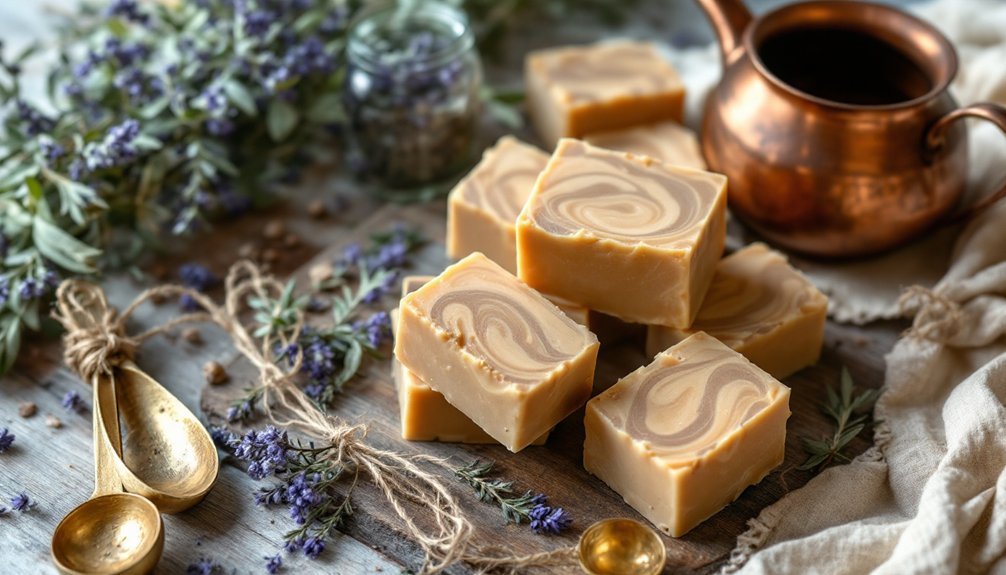



Leave a Reply